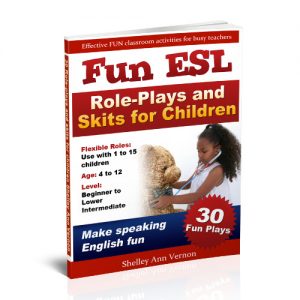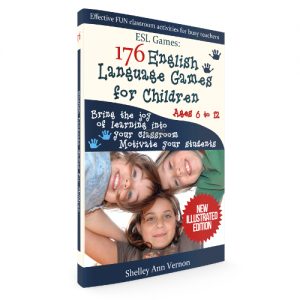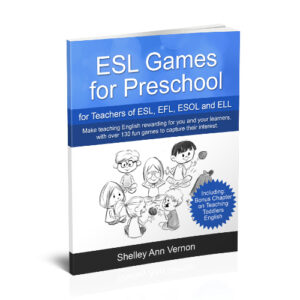Mixed-age classes are problematical, especially at preschool. Let’s hear from an ELL teacher taking a broad age group and see what problems he has and how we might resolve them. If you are also teaching children in mixed-age classes, you might like this post.
The pupils
This teacher is teaching in a centre which supports teaching through play. There are no desks or books, only 10 kids and a space for the lesson. There is a wide age range with children between 3 and 7 years of age. However, most children are about 5, with the odd 7 and 3-year-old.
The problem
“The problem is I can’t get all of their attention at the same time. I’m used to teaching with games, but I can’t get the games started efficiently in this setup. The kids get too excited, and it’s chaotic! I try scolding them, but it has no effect. So lately, I have resorted to giving them crafts and painting, but that isn’t the most effective way to teach them English with only one hour a week. Hmph!”
Suggestions and Tips
My games books and, in particular, my plays and skits are ideal for this situation. The biggest challenge you face is combining one or two three-year-olds with the older children. Three-year-olds, unless they are turbo-charged, exceptional beings who are invited to become members of Mensa, cannot learn at the same pace as children aged seven. So it’s unfair to expect them to be able to. And it’s unfair to expect the 7 year-olds to wait around in class while the 3-year-olds learn.
So it’s a very difficult mix as far as teaching English as a foreign language goes; therefore, if you can, split the group. It’s one thing to be in an open-ended activities environment where children learn through playing with toys, sandpits, lego, and so forth. But in the case of an intensive hour-long English class, it’s not so easy to get fast results.
 If you have to teach mixed-age classes and there are no solutions to split the group, I would be inclined to let the three-year-olds hang in there and absorb what they can, but focus your lesson on the 5-7 year-olds. Ask easy questions to the younger ones, such as asking them to name “red,” while the others are learning white, silver, and gold. This way, all kids stay together on the colour theme, but you make it easier for the younger ones.
If you have to teach mixed-age classes and there are no solutions to split the group, I would be inclined to let the three-year-olds hang in there and absorb what they can, but focus your lesson on the 5-7 year-olds. Ask easy questions to the younger ones, such as asking them to name “red,” while the others are learning white, silver, and gold. This way, all kids stay together on the colour theme, but you make it easier for the younger ones.
Keep the youngsters involved
You shouldn’t completely ignore the youngest, but don’t hold everyone up while little Johnny takes an hour to learn three words. The rest of the class will be so bored that they will soon start to mess around, and you’ll have chaos. You won’t be able to teach anything to anyone at that point!
Challenge the faster learners
Aim the level of the class at the 5-year-olds. Give faster learners special tasks to keep them interested. For example, let the older or faster learners take a turn calling out the instructions instead of the teacher. Have them write things on the board for you. Have them decide if a sentence is correct or not. Ask them harder vocabulary words and quiz questions. Make them team leaders. Have them help younger learners complete a task. Keep the fast learners challenged, so they don’t become bored and go off your class. It’s quite easy to do all this when you have a small group.
Use open-ended activities or workstations some of the time
Give children an open-ended activity such as sorting or playing with vocabulary items, arranging them in order of size, colour, or use. Older children will finish sooner and can continue with spelling games while the younger ones finish.
An ideal resource for teaching mixed age groups

To handle this type of group, try my plays and skits. They are the ideal tool or curriculum for mixed ages and abilities, especially when you are lucky enough to teach small groups. The youngest can be paired up to take the same lines as an older child. They can be given actions in the skit and take the simplest lines or responses. Even if these younger kids don’t say much, they will be listening and participating, while soaking up English like a sponge. It won’t be a wasted class for them, especially if they are part of the team and enjoying themselves.
On the other hand, you may find it difficult to keep the three-year-olds in the group. Therefore, if you have to, let them play with some flashcards or toys for part of the lesson, while staying in the room, so they still hear English going on around them.
Try this free skit
Here is a free skit to try in your next mixed-age classes. First, give the better pupils more lines. Then, let the younger ones take short lines and say them together. This free skit is super easy, and it’s from my collection of 30 easy plays for children. These cover the basics for A1 and beginners English.
To prepare for the skit, you need games. Of course, you need calm games if the kids are boisterous, and there are plenty in my primary and preschool games books.
I hope you try the skit and that it goes well! Do leave a comment or any advice you might have in the comments box. I’m here to help if you need me.
Kind regards, Shelley Ann Vernon
-
Sale Product on sale
 Fun ESL Role-plays and Skits for Children
Fun ESL Role-plays and Skits for Children€19.97Original price was: €19.97.€15.33Current price is: €15.33. -
Sale Product on sale
 ESL Games book for primary & middle school children
ESL Games book for primary & middle school children€19.97Original price was: €19.97.€15.33Current price is: €15.33.Rated 5.00 out of 5 based on 2 customer ratings -
Sale Product on sale
 Preschool games book
Preschool games book€19.97Original price was: €19.97.€11.97Current price is: €11.97.




2 thoughts on “Mixed age classes”
Some of those who are outgoing can fit within any group since a young age. As for the older ones they can feel a bit reserved as what to do surrounded by all these little ones . I think they need a push . Some times it’s vice versa . It all depends on the child’s confidence levels .
I’m sharing these comments that Isabel F. sent me today:
You’r e absolutely right, teaching a mixed ability group is certainly a challenge for any ESL teacher. There are no magic tricks! As experienced teachers, we’ve all had to face a mixed ability group at one time. In addition to age differences, some students have learning disabilities making the classroom experience a true bombshell.
I personally think . with young children, you have to have a large resource file of varied activities and be able to adapt them according to how the class feels on that particular day. Keep activities simple yet interesting enough for their young minds to feel engaged.
One example could be a weather topic, get students to pick laminated weather cards and have them put them up on the board etc. Get the students to participte and make them feel important. Followup the lesson with simple worksheets according to age level. In the end a total response activity such as a song and a craft should help. In short with young children, patience is the key, make your students feel engaged, important .
I find that awarding students for good work and behaviour is a miracle in a difficult classroom, but it should be done in consecutive manner. If all fails with a difficult child, set the child apart until he/she is calm and relaxed. If he/she is overwhelemed again reinforce positive encouragement.. Get them to do a simple activity that makes them feel important.